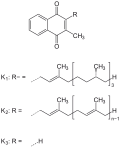The term Vitamin E refers to a group of eight molecular-structure related compounds that include four tocopherols and four tocotrienols. The tocopherols...
88 KB (10,447 words) - 22:57, 13 November 2024
folates) Vitamin B12 (cobalamins) Vitamin C (ascorbic acid and ascorbates) Vitamin D (calciferols) Vitamin E (tocopherols and tocotrienols) Vitamin K (phylloquinones...
68 KB (6,397 words) - 21:53, 2 November 2024
Vitamin E deficiency in humans is a very rare condition, occurring as a consequence of abnormalities in dietary fat absorption or metabolism rather than...
7 KB (806 words) - 10:23, 15 September 2024
Vitamin K is a family of structurally similar, fat-soluble vitamers found in foods and marketed as dietary supplements. The human body requires vitamin K...
69 KB (7,757 words) - 14:42, 24 September 2024
Vitamin A is a fat-soluble vitamin that is an essential nutrient. The term "vitamin A" encompasses a group of chemically related organic compounds that...
108 KB (12,499 words) - 06:04, 23 October 2024
Vitamin deficiency is the condition of a long-term lack of a vitamin. When caused by not enough vitamin intake it is classified as a primary deficiency...
49 KB (3,959 words) - 23:35, 27 October 2024
Vitamin C (also known as ascorbic acid and ascorbate) is a water-soluble vitamin found in citrus and other fruits, berries and vegetables. It is also a...
145 KB (15,194 words) - 02:59, 11 November 2024
Antioxidant (section Vitamin E)
prevent damage from oxidative stress. Known dietary antioxidants are vitamins A, C, and E, but the term antioxidant has also been applied to numerous other...
94 KB (10,255 words) - 23:25, 13 November 2024
María Cordero Hardy (section Vitamin "E" research)
physiologist, educator and scientist whose research on vitamin E helped other scientists understand how vitamins affect the human body. Cordero Hardy (birth name:...
5 KB (563 words) - 02:35, 5 November 2024




